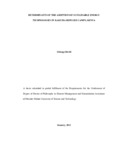| dc.description.abstract | Sustainable Energy Technologies (SETs) are expected to contribute to the achievement
of the Sustainable Development Goals that cover all persons including those in refugee
camps. The SETs are vital in refugee households for cooking, lighting and heating and
enables achievement of good health, reduces energy poverty and conserves environment.
Kenya is a host of over 500 million refugees and committed to nationally determined
contributions targets, a 30% reduction from the projected emissions of 143 MtCO2e thus
has an input to promoting environmental and human health. Although SETs are well
known, adopting them has been a major challenge for humanitarian actors and refugees
themselves yet there exist limited empirical studies to address this concern. One in eight
of the total premature deaths each year are attributed to respiratory and cardiovascular
diseases caused by indoor air pollution in refugee camps. This study is an attempt to fill
this gap by assessing the determinants of the adoption of SETs in Kakuma refugee
camps, Kenya. Specifically, the study sought to examine the existing sustainable energy
technologies being used in Kakuma refugee camps; establish socio-cultural factors
influence on the adoption of SETs; investigate the market factors influence on adoption
of sustainable energy technologies and evaluate the strategies used for adoption of
sustainable energy technologies in Kakuma refugee camps. The study was guided by
innovation diffusion theory and theory of planned behaviour. The study employed
concurrent mixed designs taking descriptive cross-sectional and correlation research
designs. The study population included 1000 refugee household heads trained on SETs in
2018, 29 UNHCR implementing agencies, 13 zone leaders and 10 sustainable energy
(SE) market organizations within the camp. Random sampling was used to select refugee
respondents, purposive sampling was used to select key informants and census was
adopted for FGD participants and SE market organizations. The quantitative tool
employed was a structured questionnaires and applied to 286 refugee household
respondents. The qualitative tools employed were interview and FGD guides and an
observation check list. The instruments were pre-tested in a pilot study in Kalobeyi due
to its similarity with camps to check for their reliability and validity. Data was analysed
both descriptively and inferentially using Statistical Package for Social Science (version
25). The study findings revealed the existing SETs adoption rate was 40.39% that
include rechargeable torches, battery torches, solar home systems, charcoal and ethanol
stoves, solar cookers and LPG stoves. The result from the regression model indicate
socio-cultural factors, market factors and subsidy initiatives had a significant positive
influence on adoption of SETs and are statistically significant at 5% level. The study
concludes socio-cultural factors, subsidy, and market factors have influences on adoption
of sustainable energy technologies as indicated by the values β1 = 0.337, t = 2.762,
p<0.05; β2 = 0.259, t = 2.564, p<0.05; and β3 = 0.106, t = 2.465, p<0.05 respectively.
The study recommends UNHCR should develop training programs to bring about sociocultural
changes, promote SETs that meet end user requirements for sustainable market
and adopt effective awareness creation strategies on subsidy initiatives to bring about
adoption of SETs. | en_US |

